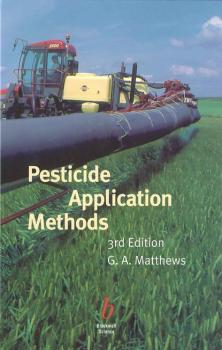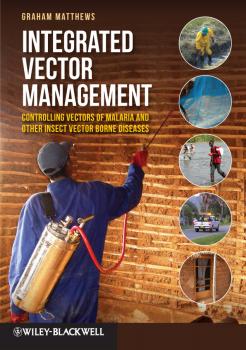ТОП просматриваемых книг сайта:
Graham Matthews
Список книг автора Graham MatthewsАннотация
Over the last five decades pesticides have undoubtedly helped to increase agricultural production and control vectors of disease, however the environmental impact of long term agro-chemical use has been cause for concern along with the effects on human health. In Pesticides, Graham Matthews begins by looking at the developmental history of pesticides, and how crop protection was achieved before they were in use, how pesticides are registered for use and what happens to pesticides in food and the environment. Pesticide application and operator safety is investigated and the future of pesticides in light of the development of genetically modified crops is explored. Provides commercially important information for the agro-chemical industry Addresses all aspects of public concern relating to human health and the environment, including spray drift, bystander, resident and worker exposure Looks at the future of pesticides in light of the increasing prevalence of genetically modified crops Collecting together the most recent research in the area in a single volume, this book is a vital resource for agricultural scientists, agronomists, plant scientists, plant pathologists, entomologists, environmental scientists, public health personnel, toxicologists, crop protection personnel and all those involved in the agrochemical industry and government pesticide registration and legislation.
Аннотация
Pesticide Application Methods is the standard work for all those involved in crop protection. This fully revised edition provides up-to-date information on the different types of application techniques and how they should be used to ensure efficient and effective pest control. Detailed information is provided on the role of chemical control in crop protection: targets, formulations and droplets, spray quality and the choice of nozzles are discussed, as are improvements in the design of new equipment, safety precautions and maintenance issues. Two new chapters highlight the application of biological pesticides and equipment used in the evaluation of pesticides. This important new edition is a commercially important reference tool and will be of great use and interest to all those working in crop protection, including agricultural entomologists and plant pathologists, pesticide scientists, advisors and consultants, large-scale growers, agricultural and horticultural scientists, agrochemical industry personnel including those involved in equipment supply and product formulation. Libraries in government and commercial research establishments, universities and agricultural colleges and anywhere the subject is taught or studied should have multiple copies of this definitive book on their shelves.
Аннотация
Pesticide Application Methods is the standard work on the subject for all those involved in crop protection. This fully updated Fourth Edition takes account of the considerable changes in legislation, especially within the European Union, affecting some pesticides and how they can be applied. With greater emphasis now on protecting the environment, an additional chapter in this edition describes the importance of managing treatments to minimise spray drift, and the chapter on applying biopesticides has been updated, with the assistance of Paul Miller and Roy Bateman respectively. Basic information on the role of pesticides in integrated pest management is given with a discussion on the importance of defining the target and choice of spray spectrum to optimise delivery. The range of droplets and types of equipment for different methods of application, including seed treatment, are described with information on safe use and maintenance. Pesticide Application Methods, 4th Edition, provides an essential reference for all those involved in crop protection, including entomologists, plant pathologists, weed scientists and agricultural engineers, whether researchers, consultants or those training in international, government or academic organisations, or the plant science industry. Libraries in all universities and research establishments where agricultural and biological sciences are studied or taught should have copies of this excellent new edition on their shelves.
Аннотация
Crop protection continues to be an important component of modern farming to maintain food production to feed an expanding human population, but considerable changes have occurred in the regulation of pesticides in Europe in the last decade. The aim has been to reduce their impact on people and the environment. This has resulted in a major reduction in the number of chemicals approved for application on crops. In other parts of the world, a continuing expansion in the growing of genetically modified crops has also changed the pattern of pesticide use. In this second edition, Graham Matthews, updates how pesticides are registered and applied and the techniques used to mitigate their effects in the environment. Information on operator safety, protection of workers in crops treated with pesticides and spray drift affecting those who live in farming areas is also discussed. By bringing together the most recent research on pesticides in a single volume, this book provides a vital up to date resource for agricultural scientists, agronomists, plant scientists, plant pathologists, entomologists, environmental scientists, public health personnel, toxicologists and others working in the agrochemical industry and governments. It should assist development of improvements in harmonising regulation of pesticides in countries with limited resources for registration of pesticides.
Integrated Vector Management. Controlling Vectors of Malaria and Other Insect Vector Borne Diseases - Graham Matthews
Аннотация
Diseases transmitted by insects continue to have a major impact on human populations. Malaria, dengue, onchocerciasis, sleeping sickness and leishmaniasis all adversely affect man. Malaria is one of the most important causes of child mortality and reduces economic development in many countries, with agricultural productivity often greatly reduced, as many vectors are active in the wet season favourable for crop production. Vector control is crucial to reduce the extent to which drugs are needed to treat the diseases, as the parasite can become resistant, or the drugs are often too expensive for those living in rural areas and urban slums most affected by these diseases. Chemical control of vectors is often the only method that can reduce vector populations in a disease epidemic, but with vectors developing resistance to insecticides, there is increasing awareness that a single control method is often insufficient and also that chemical control must be integrated where possible with other control measures. In Integrated Vector Management, Graham Matthews covers the main chemical methods of vector control, including the use of indoor residual spraying, space treatments, the use of treated bed nets and larviciding, but also stresses the importance of drainage schemes and improvement of houses to prevent access of indoor vectors, techniques that have largely been responsible for reducing the risk of vector borne diseases in Europe and the USA. This book combines practical information from successful vector control programmes, including early use of DDT, and recent research into a vital resource for all those now involved in combating insect vector borne diseases. Integrated Vector Management is an essential tool, not only for medical entomologists and those directly involved in government health departments, but also for all those who provide the skills and management needed to operate successful area-wide vector management programmes. Libraries in all universities and research establishments world-wide, where biological sciences, medicine and agriculture are studied and taught should have multiple copies of this important book.





